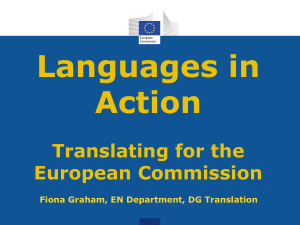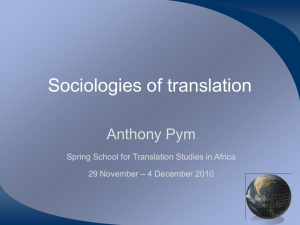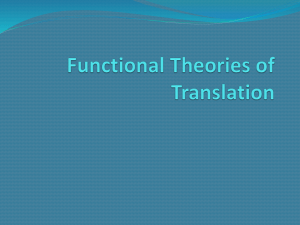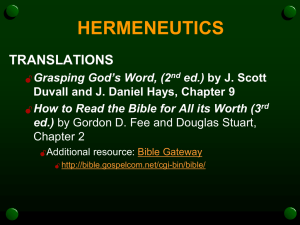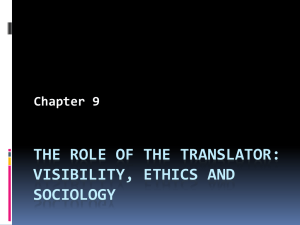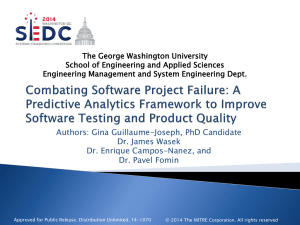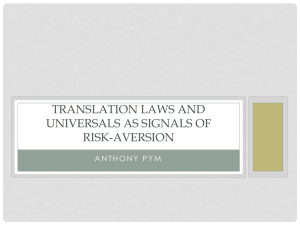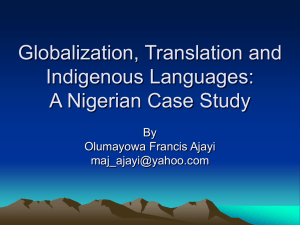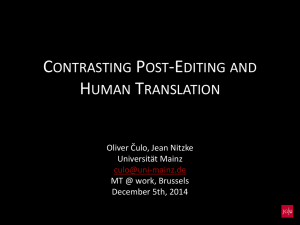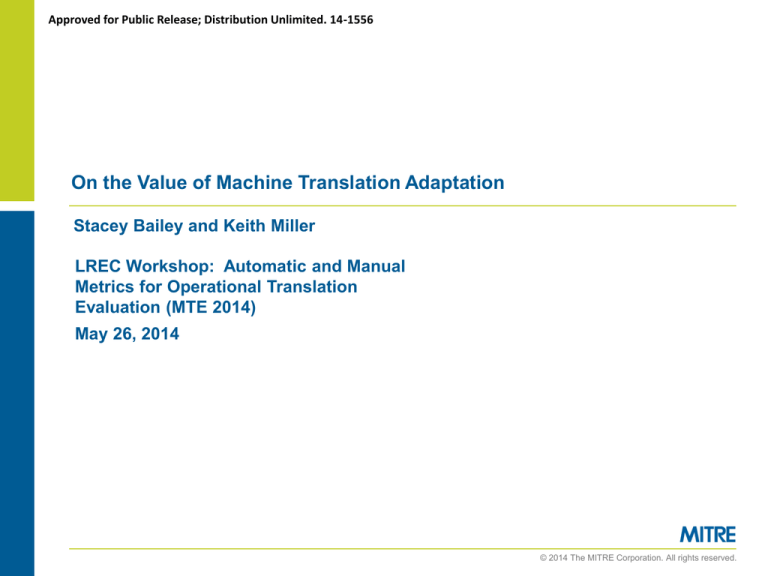
Approved for Public Release; Distribution Unlimited. 14-1556
On the Value of Machine Translation Adaptation
Stacey Bailey and Keith Miller
LREC Workshop: Automatic and Manual
Metrics for Operational Translation
Evaluation (MTE 2014)
May 26, 2014
© 2014 The MITRE Corporation. All rights reserved.
|2|
MT, DT, DTMT
Domain tuning (DT): Tailoring a machine translation (MT) system to
(ideally) better translate the kinds of data users want to translate.
– Training MT using data that is representative of a topic’s subject matter
(e.g., scientific and technical literature)
– Adding terminology that is relevant to that subject matter
Does DTMT improve the quality of MT output?
– What do you mean by ‘improve’?
If so, what’s the best way to go about DT?
– What do you mean by ‘best’?
What are the trade-offs for different approaches to DT?
– Oh, and is it worth the effort?
© 2014 The MITRE Corporation. All rights reserved.
|3|
What We Collected
Chinese-English parallel texts in the cyber domain
10 abstracts (with a total of roughly 70 segments) were selected for a taskbased evaluation.
Three additional translations were produced for each test segment for a total
of four reference translations.
© 2014 The MITRE Corporation. All rights reserved.
|4|
What We Thought
Hypothesis 1. DT improves the quality of machine translation output over
baseline capabilities, as measured by automatic evaluation metrics.
Hypothesis 2. Human translation time can be reduced by requiring human
translators to post-edit the output of DTMT systems.
Hypothesis 3. The linguistic quality of the target language document can be
improved by requiring human translators to post-edit the output of DTMT
systems.
© 2014 The MITRE Corporation. All rights reserved.
|5|
What We Measured
Automatic evaluation across all four domains
– MT evaluation scores with and without DT
BLEU, METEOR, ROUGE, WER, TER
Task-based evaluation for a subset of the Cyber data
– MT evaluation scores for 10 experimental conditions (next slide)
BLEU, METEOR, ROUGE, WER, TER
HTER (Human-mediated translation error rate )
Relative translation rates – Total time to complete a translation (in minutes)
relative to the length (number of characters) of the source Chinese text
Translator judgments – Questionnaire responses about MT utility and quality
Quality control (QC) judgments for translated segments
– Ratings for meaning and grammaticality
– Counts of missing and incorrectly translated terms
© 2014 The MITRE Corporation. All rights reserved.
|6|
What We Tested
Types of DT:
– Statistical MT models: Training a custom engine using parallel, domainspecific data
– Domain-specific glossaries: Lightweight adaptation with terms
The MT systems: Two commercial off-the-shelf MT engines
The experimental conditions:
– For each MT system
Baseline. Translation using the MT engine without any DT.
Lexicon. Translation using the MT engine plus lightweight DT with a found domain-specific lexicon.
Parallel Data. Translation using the MT engine plus a statistically retrained engine based on the training
data.
Lexicon + Parallel Data. Translation using the MT engine with a statistically retrained engine and a found
lexicon.
– Plus:
Source Language + Term Highlighting. Manual translation that does not use MT but does use a domainspecific lexicon for highlighting found terms with glosses
Source Language Text Only. Manual translation with no MT or term highlighting.
© 2014 The MITRE Corporation. All rights reserved.
|7|
What We Found
Hypothesis 1. DT improves the quality of machine translation output over baseline
capabilities, as measured by automatic evaluation metrics.
DT did improve the automatic scores, but the BLEU scores never improved above the mid 20s.
Hypothesis 2. Human translation time can be reduced by requiring human translators
to post-edit the output of DTMT systems.
Results neither support or refute this hypothesis. Translation rates were faster for some MT
conditions and slower for others.
Translators were slowest on output from the two MT conditions with the most involved DT (i.e.,
DT combining an MT engine trained on domain-specific data and a domain-specific glossary).
Translation times for source texts enhanced with term glosses were about the same or slower
than those for translating the source texts from scratch.
Hypothesis 3. The linguistic quality of the target language document can be improved
by requiring human translators to post-edit the output of DTMT systems.
There was a clear pattern of improving (i.e., decreasing) HTER scores with customization for
one MT engine, but a mixed pattern with the other MT engine. But this does not speak to the
final translation quality after post-editing.
Translators’ own opinions of the quality of the resulting translations were largely that MT had no
effect.
Additional adequacy, fluency and error data have been collected but not yet analyzed.
© 2014 The MITRE Corporation. All rights reserved.
|8|
What We Suspected
Baseline MT might be of such low quality that the meaning may simply not be
recoverable from the output provided.
Translators have no option but to start from scratch, even when asked to post-edit.
DT might improve the quality of the MT output but only enough to cause translators to
take more time to consider the output rather than discarding it out of hand.
Average Translation Rate (Characters/Minute)
10
8
6
Averaged Rate
Translator Char/Min Trend
4
2
0
0.00
0.08
0.15
0.25
0.35
MT Quality Score (notional)
© 2014 The MITRE Corporation. All rights reserved.
0.45
0.50…
|9|
What We Did Next
The work raised more questions than it answered about the relationship
between automated metrics, MT quality and the usefulness of MT for
operationally focused tasks, so we…
– proposed a workshop!
(We also began follow-on work with a different language pair and data
that might put us on a different starting point on the quality-productivity
curve.)
© 2014 The MITRE Corporation. All rights reserved.


